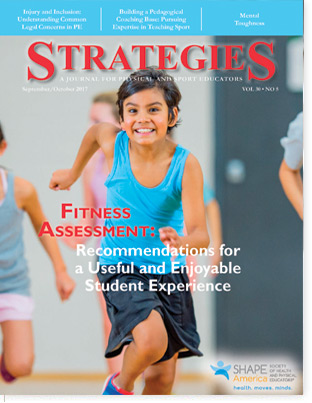 Strategies Table of Contents
Strategies Table of Contents
Fitness Assessment: Recommendations for an Enjoyable Student Experience
Sharon R. Phillips, Risto Marttinen, and Kevin Mercier

The thought of physical education often causes adults to remember hanging on a pull-up bar in front of the entire class and struggling to complete a single pull-up. One by one, students would take their turn hanging in front of their peers, while attempting to pull their chin up and over the bar. Some students could perform one, maybe two pull-ups easily. Others contorted their bodies or kicked their legs like frogs to help pull themselves upward, while still others hung there, trying to no avail to even bend their arms. Many people would likely cringe at the memory of those students who were horrified when they heard their name called to step up to that bar. Unfortunately, students who could and students who could not perform a pull-up likely already knew if they were about to show off their strength or be embarrassed in a very public forum. What was the purpose of this exercise? Research suggests that often nothing was gained; students were not motivated to improve their fitness nor did they learn much about physical activity as a result of this humiliating experience (Cale & Harris, 2009).
Fortunately, in most places, the days of promoting negative
experiences through fi tness assessment highlighted by pull-ups
and the mile run (in which the slowest student had to shuffl e
across the fi nish line in front of a snickering class) are gone.
Today, fi tness assessment is often used appropriately (e.g., not
in front of an audience) to help students learn more about fi tness
and physical activity; it can even support the promotion of
positive attitudes toward physical activity (Silverman, Keating,
& Phillips, 2010)! Research has suggested that students who
develop positive attitudes toward physical education may lead
more active lives (Solmon, 2003). Fitness assessment is part of
physical education and can contribute to the formation of attitudes
that could determine students’ lifelong physical activity
levels. Th e purpose of this article is to share information with
teachers about how fi tness assessment should be used in their
physical education classes and to share strategies that will help
students develop positive attitudes toward being active.
Recommendations for Appropriate Fitness Assessments
Fitness education and the assessment of health-related fi tness
components should be part of a year-long curriculum (Silverman,
Keating, & Phillips, 2010), which is the fi rst recommendation.
Fitness education is defi ned by SHAPE America
– Society of Health and Physical Educators (2012, p. 1) as
“the instructional and learning process of acquiring knowledge,
skills and values; experiencing regular participation in physical
activity; and promoting healthy nutrition choices to achieve
life-enhancing health-related fi tness.” Teachers should be
able to identify how they will plan and teach lessons that allow
students to gain knowledge through physical education experiences
within each component of health-related fi tness. For
example, sixth-grade students participating in the Progressive
Aerobic Cardiovascular Endurance Run (PACER) assessment
should learn that they are exercising their heart muscle and link
this activity to the purpose of cardiovascular fi tness. Consistent
reinforcement of health-related fi tness principles within
lessons throughout the year allows students to understand the
importance of fi tness assessment as a way to measure their current
fitness levels.
To read the rest of this article,
click here to download a pdf.